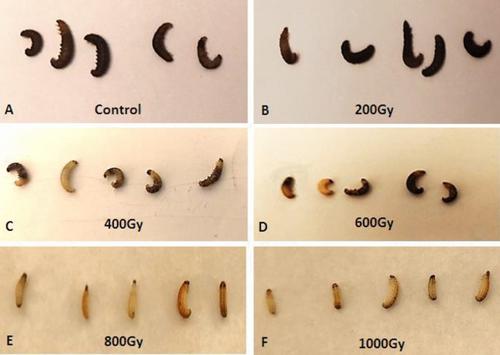Scientific Reports ( IF 3.8 ) Pub Date : 2023-11-29 , DOI: 10.1038/s41598-023-48154-w Ali Hamza 1 , Nagwan Zahran 1

|
To determine the effects of gamma radiation on the melanization process and phenoloxidase activity, Ephestia cautella larvae were exposed to dosages of 200, 400, 600, 800, and 1000 Gy. After irradiation, the number of non melanized larvae and the number exhibiting a slight melanization usually increased. The degree of melanization in treated larvae differed significantly from untreated larvae. The amount of melanin usually decreases as the dosage increases and as time passes after the treatment. The results of the phenoloxidase assay indicate that the enzyme activity responds differently to radiation. For instance, at doses of 200, 400, and 800 Gy, the enzyme activity remained consistent in both control and irradiated larvae. However, at doses of 600 and 1000 Gy, the enzyme activity increased to 14.92 and 13.37 O.D. units, respectively, compared to 8.81 O.D. units in the control. In order to determine if irradiated larvae have been previously exposed to ionizing radiation, a quick and easy test based on phenoloxidase activity or the melanization response is presented for use in quarantine treatment. Histological changes, specifically in the pigment granules of melanin, were studied using a light microscope. Upon inspection of the unirradiated larvae, it was observed that brown melanin pigment granules were deposited in the epicuticle and exocuticle layers of the cuticle. When gamma radiation dosages were administered to larvae, it was observed that the melanin pigment gradually diminished until it vanished at the highest dose (1000 Gy).
中文翻译:

伽玛辐射引起的杏仁蛾幼虫角质层黑色素沉着变化
为了确定伽马辐射对黑化过程和酚氧化酶活性的影响, Ephestia cautella幼虫暴露于 200、400、600、800 和 1000 Gy 的剂量下。照射后,非黑化幼虫的数量和表现出轻微黑化的数量通常增加。经处理的幼虫的黑化程度与未经处理的幼虫显着不同。黑色素的量通常随着剂量的增加和治疗后时间的推移而减少。酚氧化酶测定的结果表明酶活性对辐射的反应不同。例如,在 200、400 和 800 Gy 的剂量下,对照幼虫和受辐射幼虫的酶活性保持一致。然而,在 600 和 1000 Gy 的剂量下,酶活性分别增加至 14.92 和 13.37 OD 单位,而对照中的酶活性为 8.81 OD 单位。为了确定受辐射的幼虫之前是否暴露于电离辐射,提出了一种基于酚氧化酶活性或黑化反应的快速简便的测试,用于检疫处理。使用光学显微镜研究了组织学变化,特别是黑色素色素颗粒的变化。检查未受辐射的幼虫时,观察到棕色黑色素颗粒沉积在角质层的上角质层和外角质层中。当对幼虫进行伽马辐射剂量时,观察到黑色素逐渐减少,直到在最高剂量(1000戈瑞)时消失。













































 京公网安备 11010802027423号
京公网安备 11010802027423号